Education in Bareneed has its roots anchored in The Society for the Propagation of the Gospel in Foreign Parts (SPG). The report of the SPG for the year 1821 describes Bareneed as follows:
at the latter place [Bareneed], where there is already a Church, there are 200 Protestants, where Divine Service has been performed by Mr. Surrell for the last eighteen months, previously to which it was seldom opened* The inhabitants of this place are generally well disposed, and their poverty renders them fit objects of the Society's attention.Mr. John Surrell, School-master at Baremeed [Bareneed], having produced respectable testimonials from the inhabitants of that place, has been appointed School-master and Catechist, with the usual salary, subject to the approbation of the Board, and the Bishop of Nova Scotia. He has a Sunday School of about thirty children, and he regularly performs the Church Service on Sundays. There is a very neat little Church at Baremeed, built by the inhabitants.
In 1822 there were 20 boys and 33 girls attending school (total population of Bareneed was approximately 350). This was one of the first schools in Conception Bay. In 1826 there were 57 children in school at Bareneed. In 1827 Mr Sarrell (aka Serrell see 1821 above) resigned his teaching position at Bareneed.

SPG efforts petered out with the advent of the Newfoundland School Society in 1823. The NSS was concerned mainly with setting up schools, which the SPG had not been. Although they shared an interest in making adults and children both literate and good Christians, the religious differences between the two organizations caused some friction. White, for instance, details the tensions that existed between the Anglican SPG and the Methodist-Wesleyan influences in the mainly Anglican NSS, noting that the SPG felt that the NSS was competing with it and that the NSS had formed alliances with Methodists. A further difference is that the NSS was intentionally set up to educate people of all Christian denominations (not just Anglicans), though its teachers were Anglican. Furthermore, the NSS schools did not charge tuition fees whereas the SPG schools did These frictions, however, did not hamper the growth of the NSS, and by 1833 the SPG efforts had been edged out of Newfoundland. (https://journals.lib.unb.ca/index.php/Acadiensis/article/view/20068/23083)
The Ninth Annual Meeting of The Newfoundland and British North America Society for Educating the Poor, Held at Exeter Hall, May 1832 describes the school at Bareneed (c 1831) as follows:
At Bare Need, there is a very interesting Branch School. The building is nearly completed, and the whole expence, with the exception of ten pounds presented by this Society, has hitherto been borne by the inhabitants. There have been admitted 86 Day, 113 Sunday, and 56 Adult Scholars.
In 1838 Bareneed had a Branch Teacher partially supported by the SPG.

By 1839, 100 children were reported to be attending summer school with another day school accommodating sixty children and a winter night-school which was held for young men (C.E. Dawe: 1967, Newfoundland Historical Society).
By 1853 there were indications of conflicts between the Church Society (based in England) and the local ministery regarding the running of the school at Bareneed (see below)
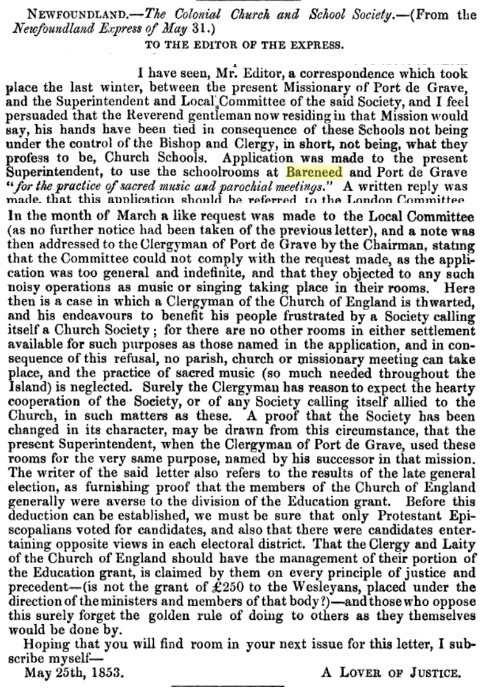
GEORGE F. PAYNE, TEACHER AT BARENEED FROM THE 1850s TO 1892
George F Payne, who was teaching at Island Cove when he married his wife Elizabeth Crane in 1849, became the School Master at Bareneed in the 1850s and remained until 1892. Extracts from his Obit below: Mr. Pane adopted the profession of teaching and was sent by the Colonial and Continent School Society to the neighboring settlement of Island Cove. From there he was soon transferred to Bareneed where he spent the greater part of. his long and honorable career of fifty years an instructor of youth… As time wore on his scholars grew to be men and women.. and he became the patriarch of the settlement.
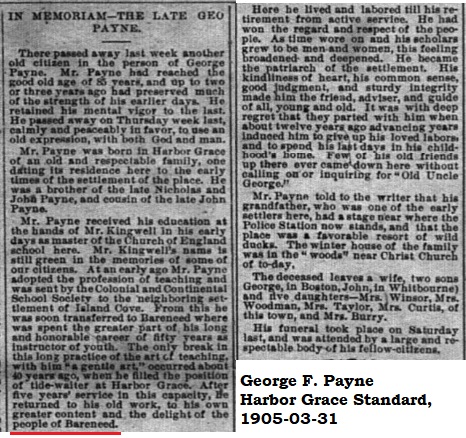
In 1858 his wife was listed as the teacher at Bareneed.

In 1858 the government passed a bill which increased the grant for education, instituted a system for the training of pupil-teachers in St. John’s colleges and re-established the Inspectorship (dormant since 1845). These changes, however, did not take full effect until later in the century (https://www.heritage.nf.ca/articles/society/education.php).
In 1874 the population of Bareneed was 591 and there were 175 children in school. Bareneed, tended to have one of the strongest school systems in Conception Bay and in later years produced an above average number of school teachers.
A further Education Act in 1876 upgraded the post of Inspector to that of Superintendent. The three denominational Superintendents were given wide powers over all aspects of the running of the public elementary schools; in effect, government transferred most of what should have been its educational responsibilities to the churches. The three denominations lost little time in opening new schools (with the Methodists in the lead), often at the expense of teachers’ salaries, which declined in the following decades. (https://www.heritage.nf.ca/articles/society/education.php).
In 1884, 82 Bareneed men went to Labrador and a new Church of England school was built. Richard Hennebury and Richard Newell, two planters, and Samuel Moore, a merchant, all lived in Bareneed and owned schooners.
The 1891 Census shows that there were two Churches (CofE & Methodist) in Bareneed but only one school; the Dock did not have either. The school in Bareneed could accommodate 120 students.
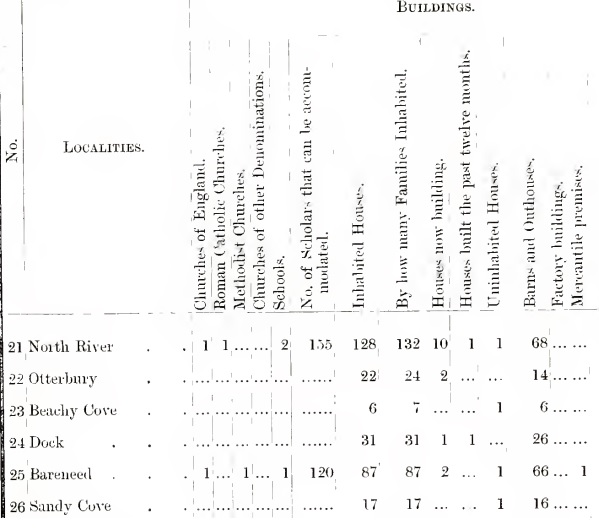
In the 1891 Census Bareneed had 329 individuals age 10+ of which 270 (82%) could read and 69% could write as well. These numbers were well above the average for Newfoundland. David Alexander in his paper on Literacy and Economic Development in Nineteenth Century Newfoundland states that the 1891 census indicates that 68% of the population ten years of age and more was literate; but only 52% could write as well as read.
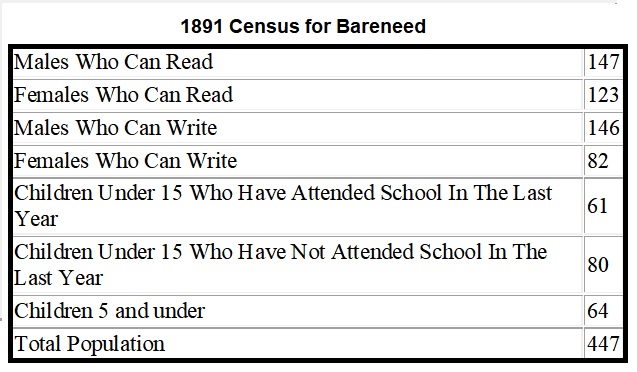
By 1893 Mr. Payne was no longer the teacher at Bareneed being replaced by William Netten (possibly relative of the C of E Minister). This was one of the few occasions when the school did not get a good report (see below)
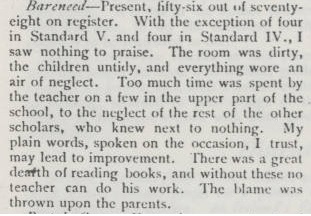
In 1905 there was also a Methodist school at bareneed with 55 students on the school register. Rebecca Seeley was the teacher.
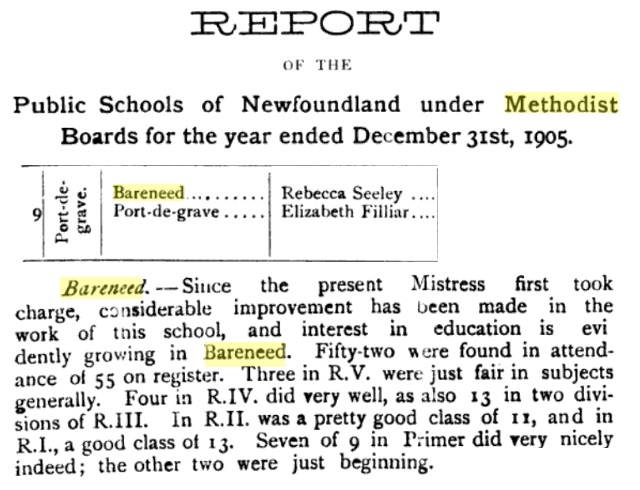
By 1910 the school was in need of repair which may have led to the construction of a new school that opened in 1912 (see below).

In the 1911 census for Bareneed (only partial data for the Dock) 8 adult children were identified as teachers (likely back living with their parents in the summer months).
| Name | Relations | Age | Occupation |
| Cyril Batten | Son | 19 | School Teacher |
| Joseph Vokey | Boarder | 18 | School Teacher |
| ? Bartlett | Daughter | 21 | Teacher |
| Annie Boone | Daughter | 21 | Teacher-C.E.B. Educ. |
| Thomas Seely | Son | 21 | School Teacher |
| Irene French | Daughter | 23 | School Teacher |
| Elsie French | Daughter | 24 | School Teacher |
| Mary Richards | Daughter | 20 | School Teacher |
A new Church of England School, St. Mark’s, opened in 1912.
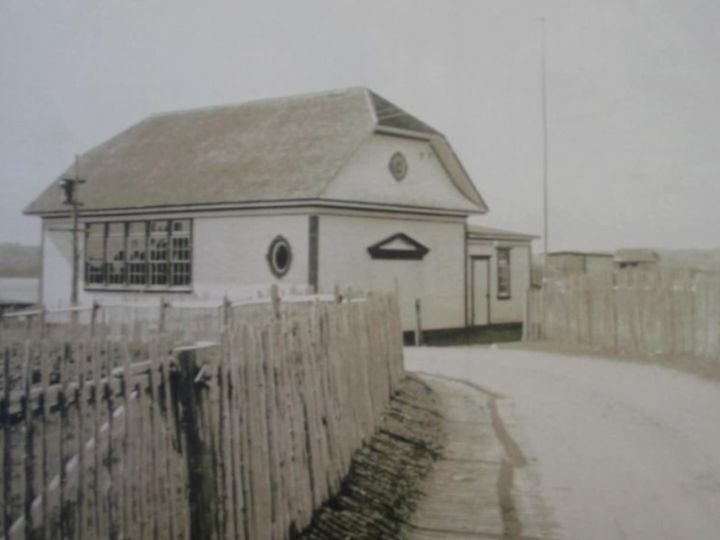
The Bareneed school and teacher received a good review in 1916.

In the summer of 1917 six teachers from Bareneed attended Summer School at St. John’s (see Table below). Five of the six were women which reflects the fact that WWI had been raging for 3 years so many young men were away.
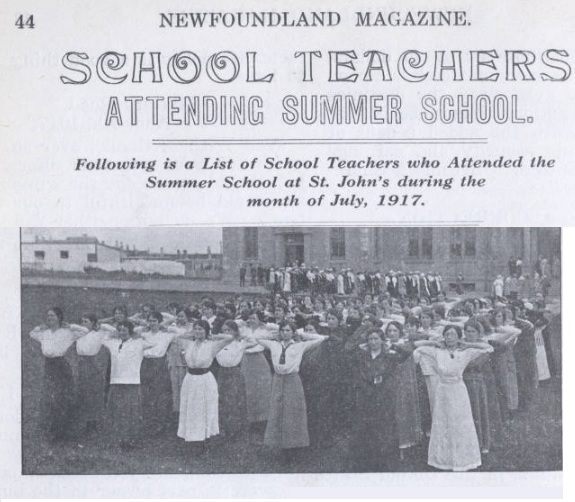
| NAME | DOB | BOARD |
| Lizzie Wilmuth Bartlett | 1897 | CoE |
| Isaac Batten | 1895 | CoE |
| Annie Boone | 1899 | CoE |
| Emmie Boone | 1892 | CoE |
| Myra S.Richards | 1895 | Met. |
| Jemima Seeley | 1897 | Met. |
You can get some indication of the role of education and teachers in Bareneed from looking at newspaper reports.

During the Christmas Holidays in 1925/26 there were nine teachers who returned home to Bareneed from other locations.

Later that year

In the 1935 Census there were 12 teachers listed in Bareneed and the Dock, most of these were teaching elsewhere and were home for the summer holidays.
| RICHARDS | John E. | Head | 39 | Teacher |
| BARTLETT | Hazel | Daughter | 30 | Teacher |
| BOONE | Mary | Daughter | 22 | Teacher |
| GREENLAND | Fred | Brother | 23 | Teacher |
| BATTEN | Herman | Son | 26 | Teacher |
| BATTEN | Victor | Son | 21 | Teacher |
| NEWELL | Vera M. | Daughter | 21 | School teacher |
| RICHARDS | Allan | Son | 28 | School teacher |
| FRENCH | Winston O. | Son | 22 | School Teacher |
| FRENCH | Gordon M. | Son | 25 | School Teacher |
| FRENCH | Harold | Son | 23 | School Teacher |
| FRENCH | Graham | Son | 20 | School Teacher |
In July 1948, B.V. Andrews, a local history buff, noted that the large number of young people leaving Bareneed to pursue teaching careers in other areas was draining the population of Bareneed. He was correct that hundreths of young people left Bareneed during this period and a significant number of those were teachers.
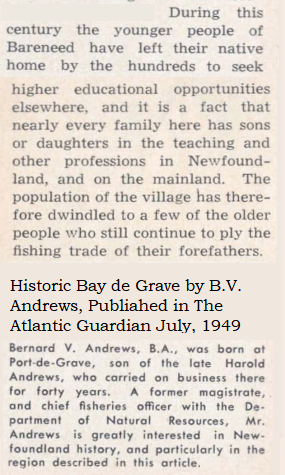
I recently compiled a list of 67 people born in Bareneed who became teachers (see below) and I likely missed a number of others. While not hundreds this is an impressive number for a community that reached a maximum population of around 600 in the 1880s and was less than half that number by 1950. There are 12 family names in the list: 13 Battens, 11 Richards, 9 Frenchs, 8 Bartletts, 8 Boones, 6 Seeleys, 5 Newells, 3 Geenlands and 1 each for Hampton, Curnew, Lacey and Stevens.
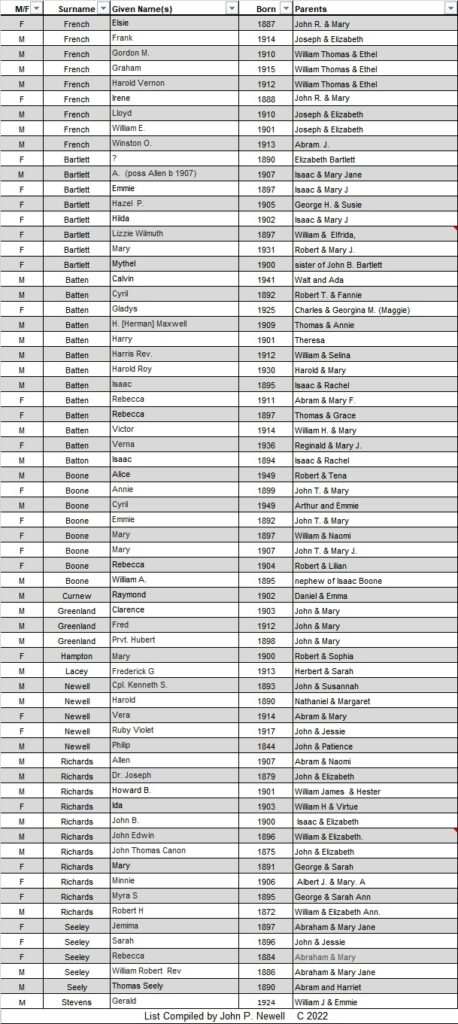
The 1890s was the decade when largest number of teaches from Bareneed were born which was when the population of Bareneed (including the Dock) reached 600. The number dropped after 1920 since the population was in a rapid decline (due to out migration) and the people remaining tended to be the elderly.
In 1941 a fire destroyed the United Church (old Methodist) school.

The number of students in school likely increased in 1942 when Newfoundland enacted compulsory education.
Newfoundland enacted compulsory schooling late, the same year it legislated free education in 1942. Compulsory ages were set between age seven and fourteen. The province raised the school leaving age to fifteen in 1951. Students attaining fifteen during the school year had to wait until the end of the school term before having the option to leave. After 1963, all provinces enforced a minimum school leaving age of either fifteen or sixteen. These limits remained for many years. Source: P. Oreopoulos, 2005, Canadian Compulsory School Laws.
The number of children in Bareneed declined in the 1940s and 1950s due to out migration and an aging population (decrease in birth rates). In the mid 1950s the high school students from Bareneed started attending St Luke’s School in Port de Grave (in 1960s both Port de Grave and Bareneed high school students were bused to Bay Roberts). The United Church School (west end of Bareneed) closed in the late 1950s. The last School in Bareneed (St. Mark’s, see photo below) closed in the mid 1960s and after this a bus took the few remaining school children to Coleys Point or Bay Roberts.

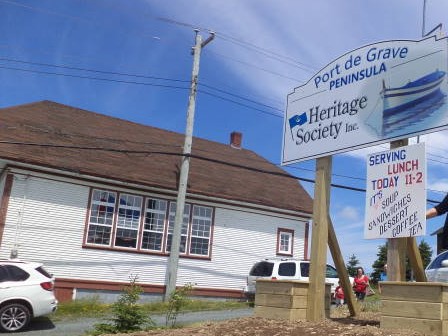
The following photographs show students from Bareneed during different time periods:
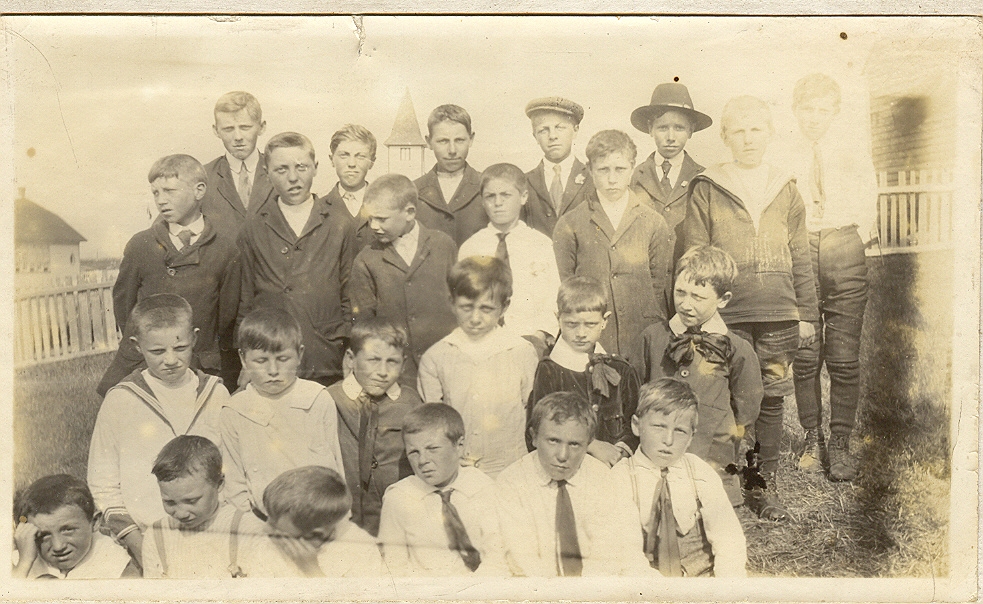
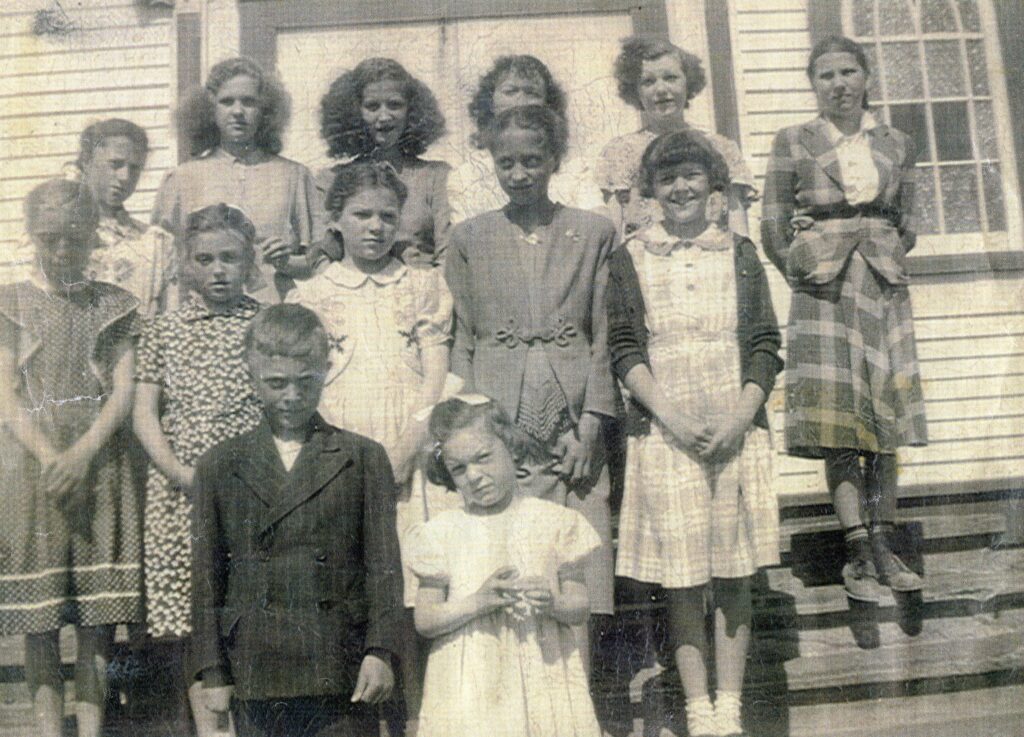
Back Row, Left to Right
Ellen Newell daughter of John and Jessie of the Dock
Emmie Mercer daughter of James and Diana
Grace Richards daughter of George and Eliza
Myrtle Bartlett daughter of John and Susie
Verna Batten daughter of Reginald and Sarah Jane
Ida Richards daughter of George and Eliza
Middle Row Right to Left
Effie Boone daughter of William and Rachel
Shirley Newell daughter of John R and Gladys
Pearl Mercer daughter of James and Diana
Marion Batten daughter of Walt and Ada of the Dock
Sandra Boone daughter of Ike Jr and Jean.
Front Row Left to Right
Calvin Batten son of Walt and Ada of the Dock
Barbra Mercer daughter of James and Diana
Photo of one of the last classes at Bareneed school before it closed.
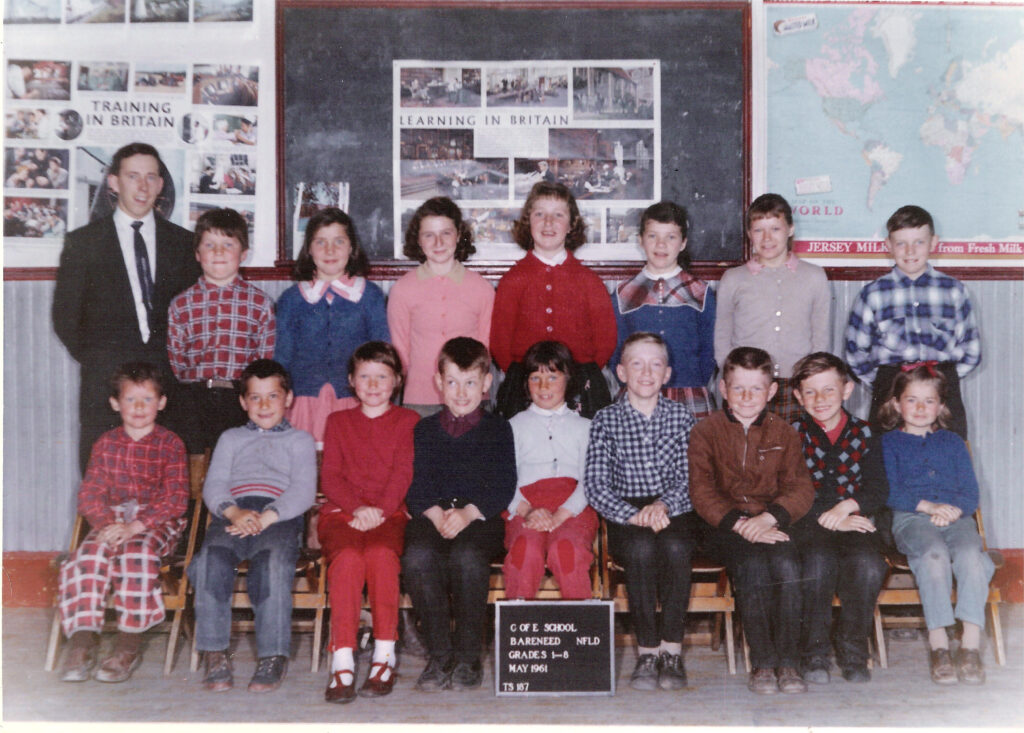
Students Back Row L to R: Roy Lush, Barbra Lush; Alice Boone; Irene Batten, Myra Mercer; Betty Richards, Cyril Boone. Front Row L to R: Roy Richards, Loyd Lush , Pearl Richards; John Newell, Beatrice Richards , Howard French, Douglas French, Donald Boone, Eileen French (thanks to Alice Boone for help with IDs). Teacher year after this Mrs Chalk.